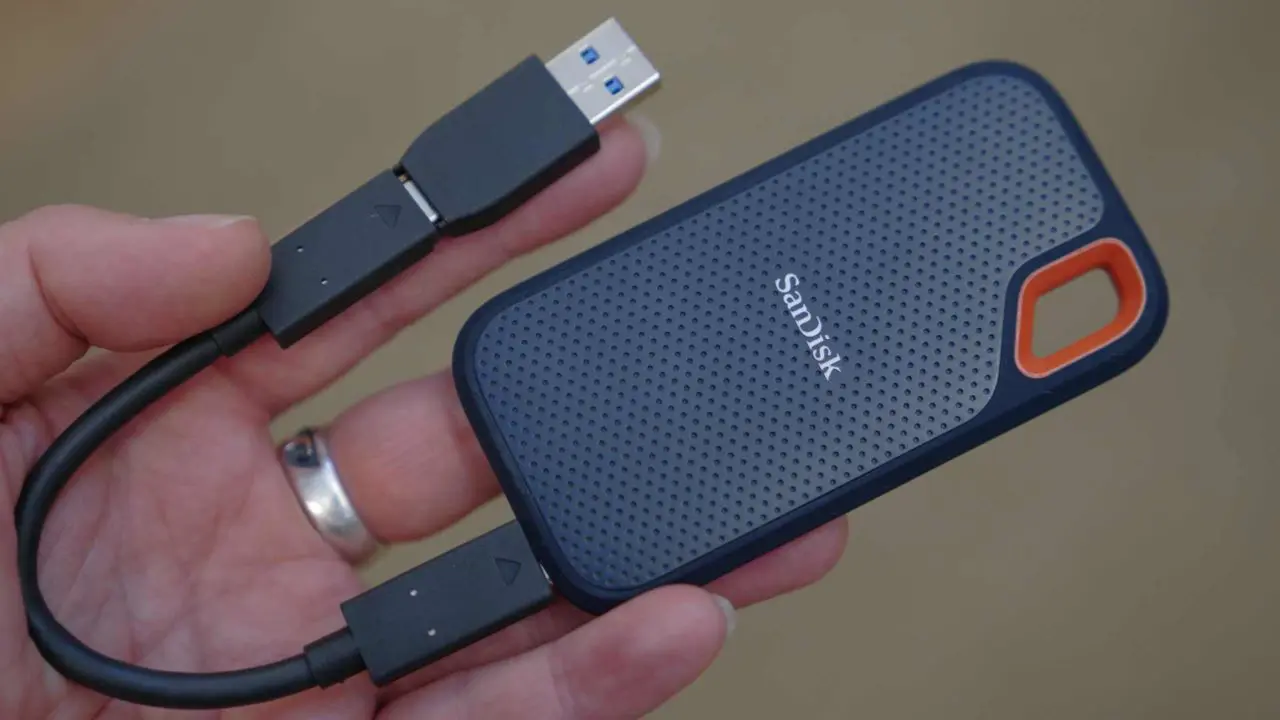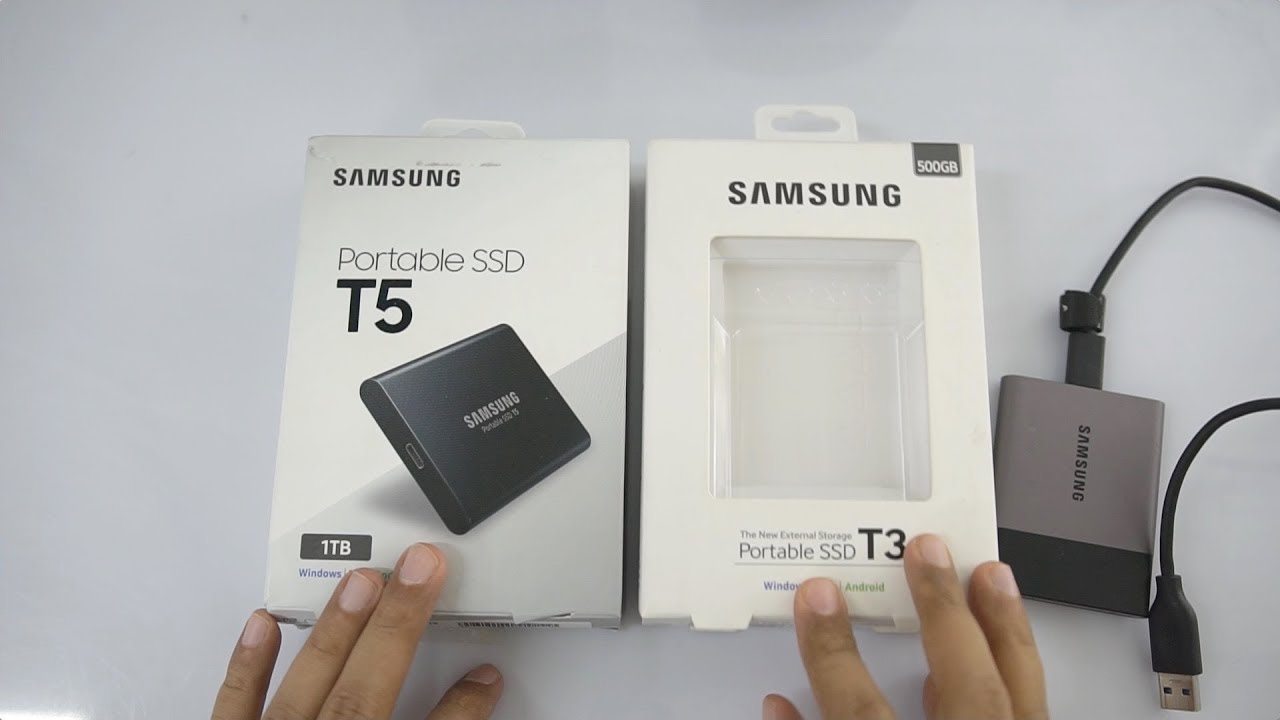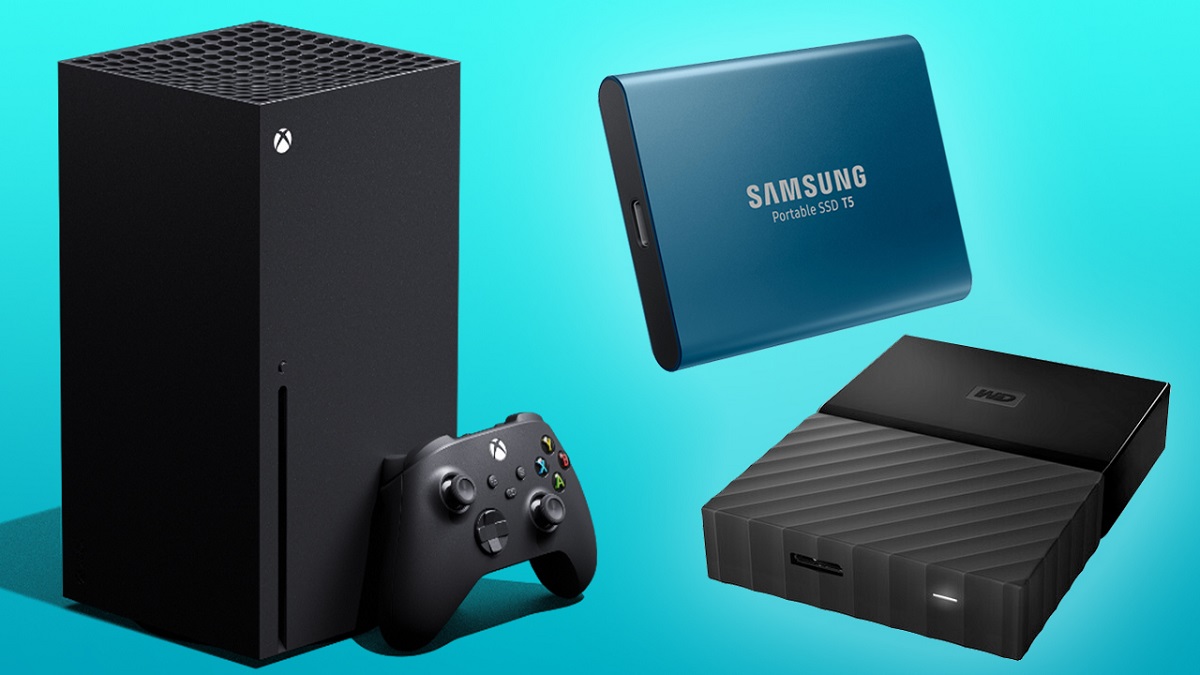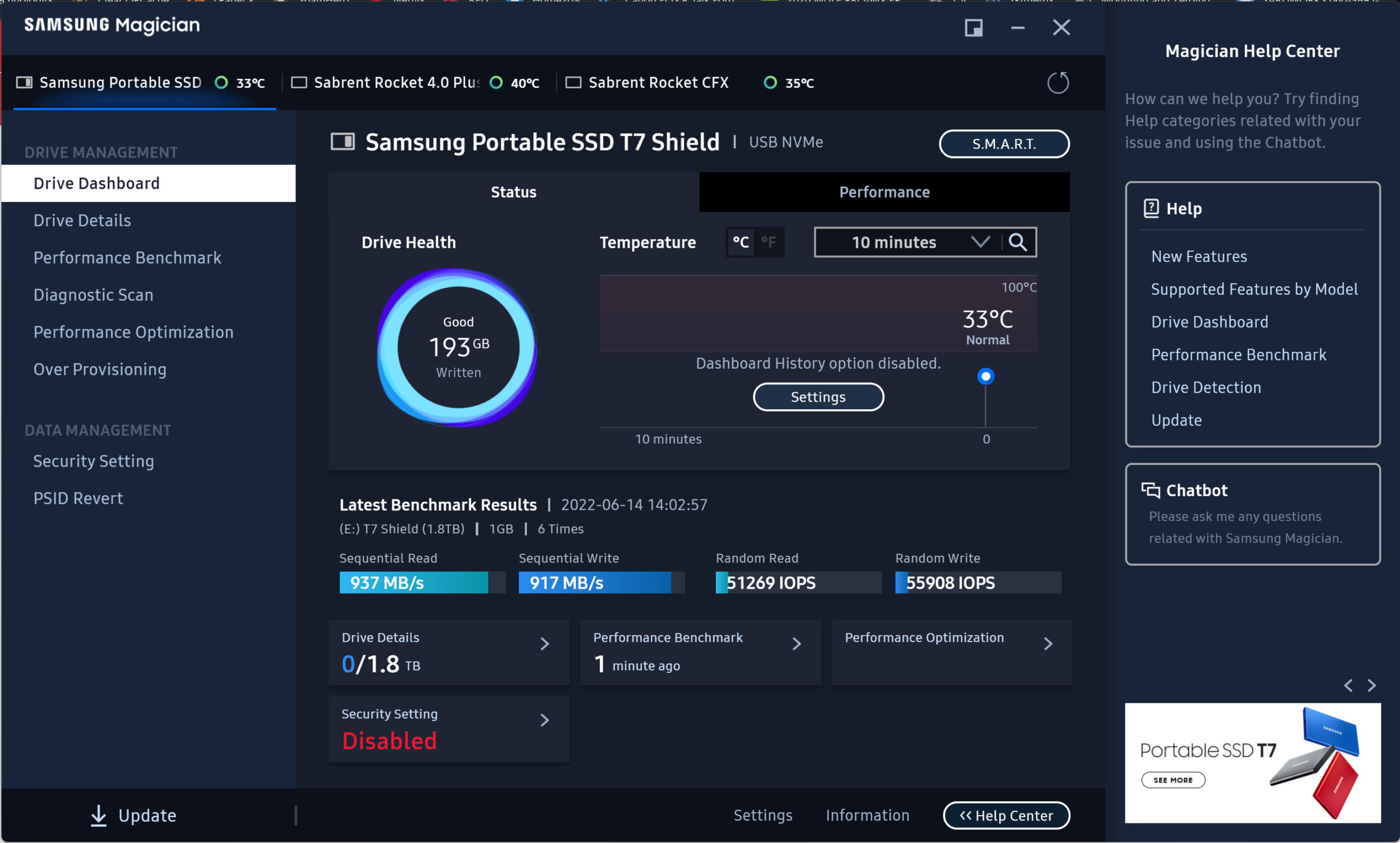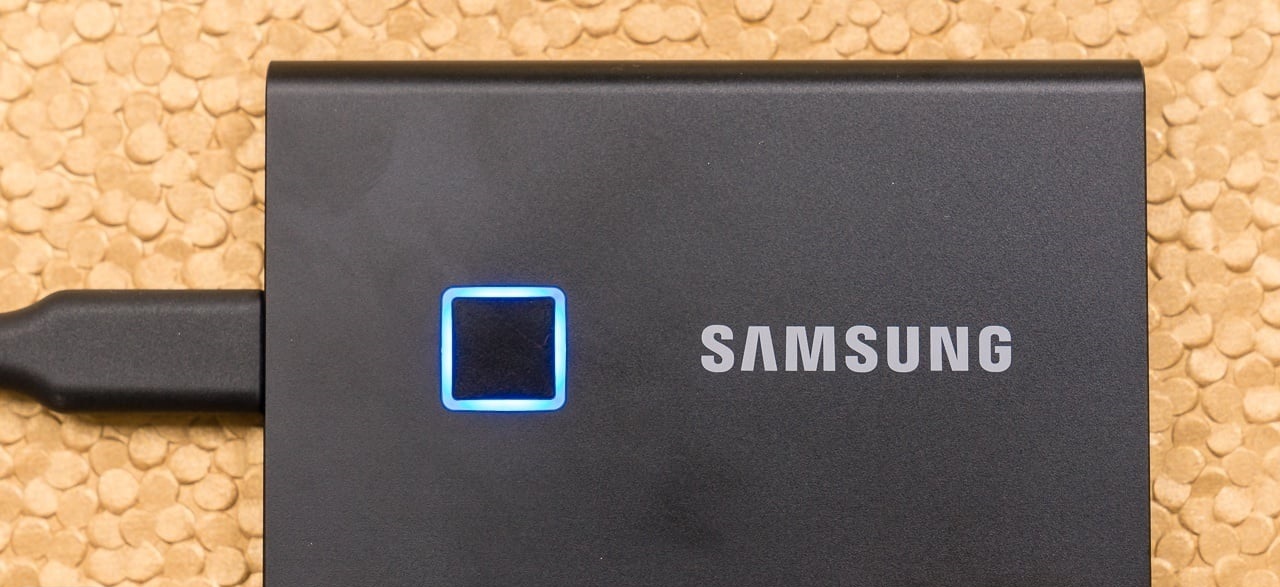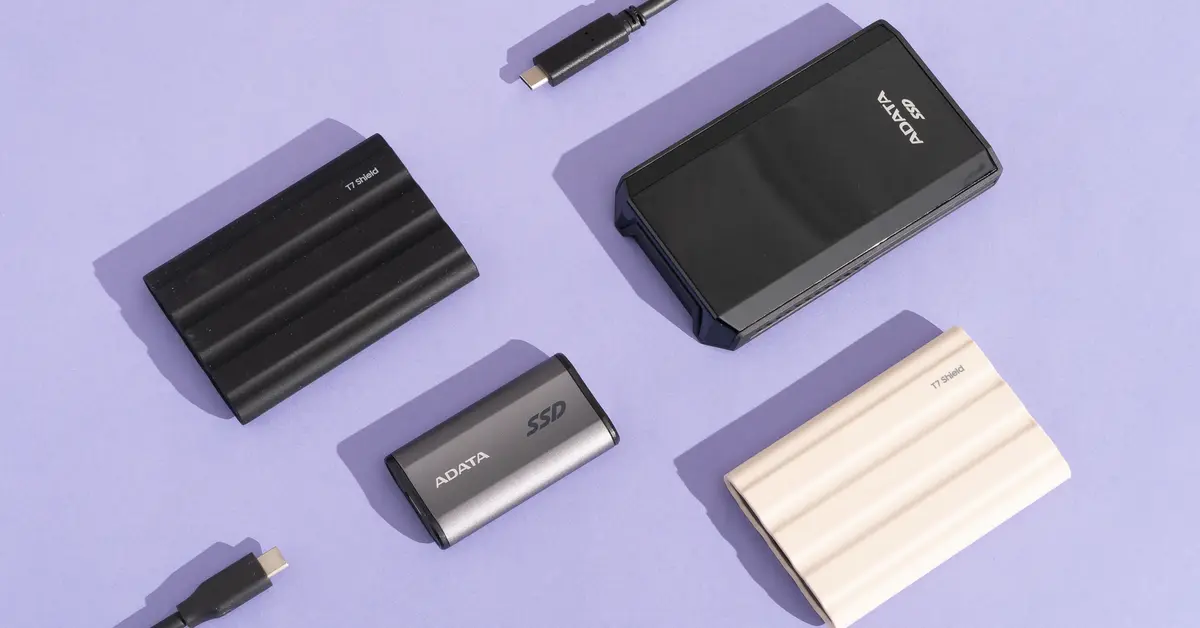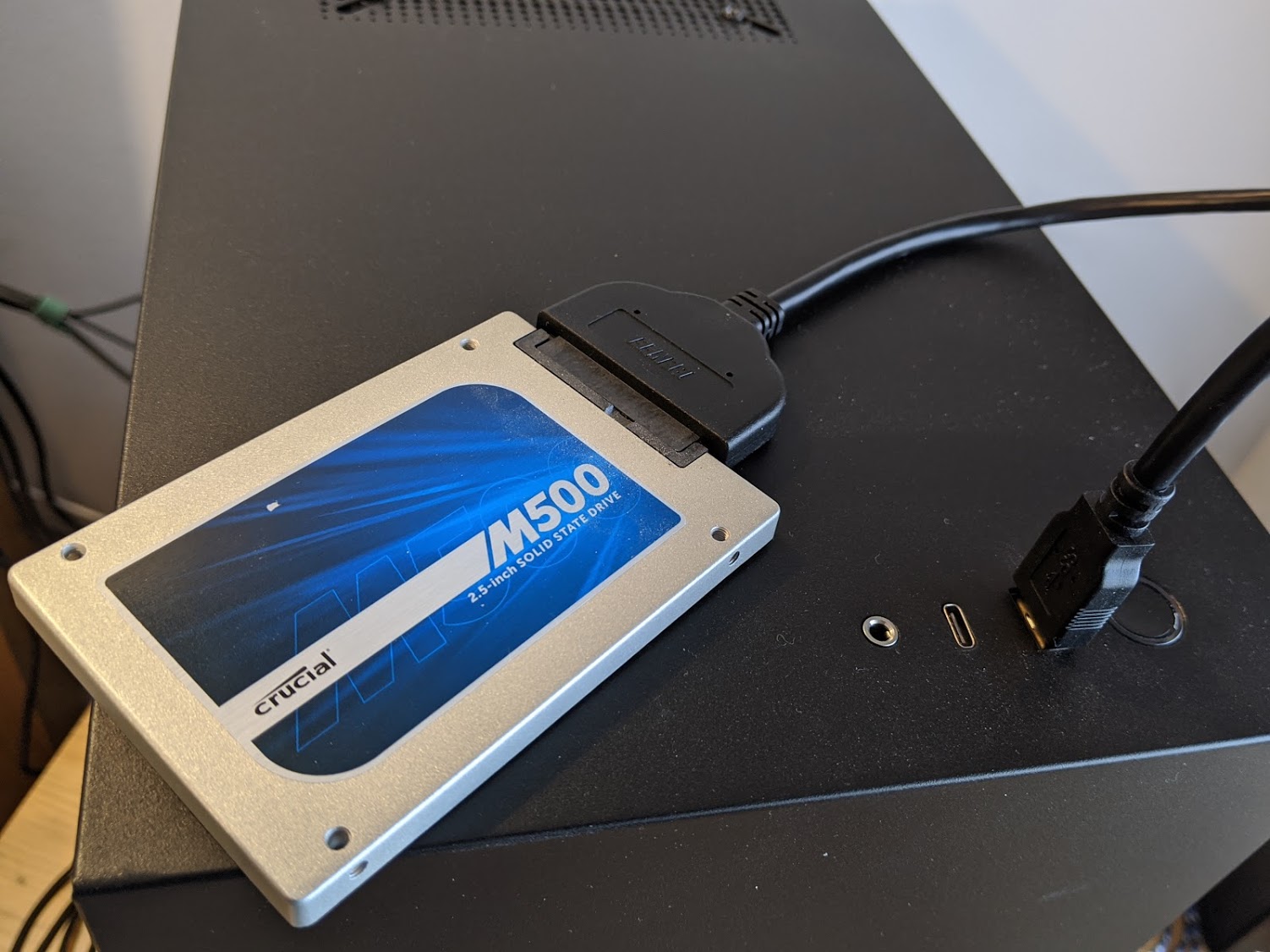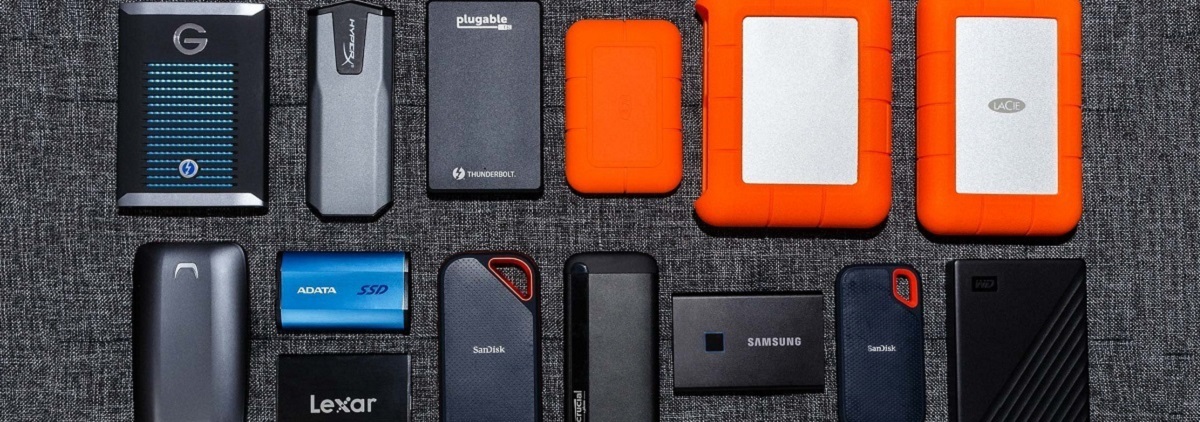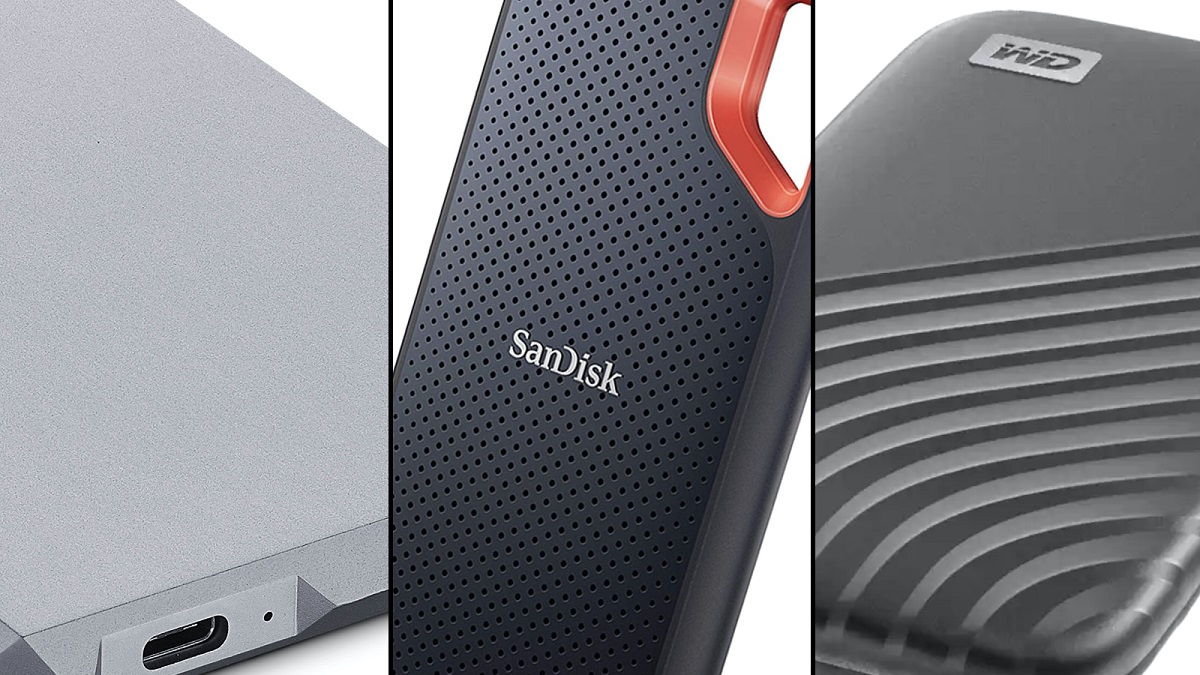Introduction
Welcome to the world of portable SSD drives! In this rapidly advancing digital age, where storage needs are constantly expanding, having a reliable and efficient external storage solution is essential. This is where portable SSD drives come into play. With their speed, compact size, and impressive storage capacity, portable SSD drives have become a popular choice for both individuals and professionals.
A portable SSD drive, also known as a solid-state drive, is a portable storage device that uses flash memory to store and retrieve data. Unlike traditional hard drives that rely on spinning disks and mechanical components, portable SSD drives have no moving parts, making them faster, more durable, and less prone to damage or data loss.
These drives have revolutionized the way we store, transfer, and access data. Whether for personal use or professional needs, a portable SSD drive offers numerous advantages over traditional storage options like external hard drives or USB flash drives. In this article, we will explore the world of portable SSD drives, their functionality, benefits, and how to choose the right one for your specific needs.
From photographers and videographers needing to store their massive high-resolution files to gamers looking for faster loading times, portable SSD drives provide a solution for a wide range of storage needs. So, if you’re someone who finds themselves constantly running out of storage space, waiting for files to transfer, or dealing with the frustration of a sluggish computer, then a portable SSD drive might just be the ultimate storage solution you’ve been searching for.
In the following sections, we will dive deeper into what exactly a portable SSD drive is, how it works, the benefits it offers, factors to consider when choosing one, popular brands and models, common uses, tips for usage and maintenance, and more. By the end of this article, you’ll have a comprehensive understanding of portable SSD drives and the confidence to make an informed decision on which one will best suit your needs.
Definition of a Portable SSD Drive
A portable SSD drive, also known as a solid-state drive, is a compact and portable storage device that utilizes flash memory technology to store and retrieve data. Unlike traditional hard disk drives (HDDs) that rely on mechanical components and spinning disks to read and write data, portable SSD drives have no moving parts. Instead, they use NAND flash memory, which provides faster data access times, enhanced durability, and improved power efficiency.
Portable SSD drives are designed to be lightweight, small in size, and highly portable, making them convenient for individuals who need to carry large amounts of data with them on the go. They typically have a USB connection interface, such as USB 3.0 or USB-C, allowing for easy and fast data transfer to and from computers, laptops, and other devices.
SSD technology has been widely adopted in the storage industry due to its numerous advantages over traditional HDDs. One of the main benefits of a portable SSD drive is its speed. SSDs can read and write data at significantly faster speeds compared to HDDs, resulting in quicker file transfers, faster boot times, and snappier application loading times.
Another significant advantage of portable SSD drives is their durability. Since they do not have any moving parts, they are more resistant to physical shocks and vibrations. This makes them less prone to damage or data loss caused by accidental drops or impacts, making them ideal for portable use.
Portable SSD drives also offer a higher level of data security. Most models come equipped with built-in encryption capabilities to protect sensitive information from unauthorized access, providing an extra layer of security for your files and documents.
Furthermore, portable SSD drives are known for their compact and sleek designs, making them easy to slip into a pocket or bag. They come in various storage capacities, ranging from a few hundred gigabytes to several terabytes, allowing users to choose the size that best fits their storage needs.
In summary, a portable SSD drive is a portable storage device that uses flash memory technology, offering faster data access, enhanced durability, improved power efficiency, and increased data security. Its compact size and convenient connectivity options make it a versatile and essential tool for individuals who require reliable, high-speed, and portable storage for their digital files.
How Does a Portable SSD Drive Work?
To understand how a portable SSD drive works, it is essential to grasp the key components and processes involved in its operation. Unlike traditional hard disk drives (HDDs), which rely on spinning disks and mechanical read/write heads, portable SSD drives utilize advanced solid-state technology.
At the core of a portable SSD drive is the NAND flash memory, which is a type of non-volatile storage technology. This means that the data stored in flash memory is retained even when the power supply is disconnected. The NAND flash memory is composed of millions of memory cells that can be electrically programmed and erased to store and retrieve data.
When you connect a portable SSD drive to your computer or device, the SSD controller inside the drive facilitates the communication between the flash memory and the host system. The controller manages the flow of data, handles error correction, and optimizes performance.
When you save or transfer data to a portable SSD drive, the controller sends the data to the flash memory, where it is written in memory cells. Unlike HDDs, which store data on spinning disks, SSDs store data in memory chips. Each memory cell can store multiple bits of data, allowing for higher data density and increased storage capacity.
When retrieving data from a portable SSD drive, the controller accesses the requested data from the flash memory chips and sends it to the host system. The lack of moving parts in SSDs significantly reduces seek times and latency, resulting in faster data access speeds compared to traditional HDDs.
Another important aspect of portable SSD drives is wear leveling. Flash memory cells have a limited lifespan and can only withstand a certain number of program/erase cycles. To maximize the lifespan and prevent premature failure of the drive, wear leveling algorithms evenly distribute data across different memory cells, ensuring that each cell wears out at a similar rate. This helps to maintain the overall performance and reliability of the portable SSD drive over its lifespan.
In terms of connectivity, a portable SSD drive typically uses a USB interface, such as USB 3.0 or USB-C, to connect to the host system. These interfaces provide high-speed data transfer rates, allowing for quick and seamless file transfers between the portable SSD drive and the computer or other devices.
In summary, a portable SSD drive works by utilizing a solid-state technology called NAND flash memory. The SSD controller manages the data flow between the flash memory and the host system. When data is saved or retrieved, it is written or read from the flash memory chips. Wear leveling algorithms ensure even distribution of data and maximize the lifespan of the drive. With its lack of moving parts and advanced technology, a portable SSD drive offers faster data access speeds, enhanced durability, and reliable performance for storing and accessing your valuable digital files.
Benefits of Using a Portable SSD Drive
Using a portable SSD drive offers numerous advantages over traditional storage options like external hard drives or USB flash drives. Whether you’re a professional or an everyday user, the benefits of a portable SSD drive can greatly enhance your storage experience.
One of the major benefits of a portable SSD drive is its speed. SSDs are known for their lightning-fast data transfer rates, allowing you to quickly transfer large files or access data with minimal delay. With read and write speeds significantly faster than traditional hard drives, a portable SSD drive can greatly improve your workflow, whether you’re editing videos, working with large datasets, or transferring files between devices.
Portability is another key advantage of using a portable SSD drive. These drives are designed to be compact, lightweight, and easily fits in your pocket or bag. With their small form factor, you can carry your entire digital library of documents, photos, videos, and music wherever you go. This makes it convenient for students, professionals, and travelers who need quick and easy access to their data without the hassle of carrying bulky equipment.
Durability is also a notable benefit of portable SSD drives. Unlike traditional hard drives with delicate moving parts, SSDs have no mechanical components that can break or fail. This makes portable SSD drives more resistant to shock, drops, and physical damage. With their solid-state design, you can have peace of mind knowing your valuable data is stored securely and protected against accidental damage.
Energy efficiency is another advantage of portable SSD drives. Since they do not have spinning disks or mechanical parts, SSDs consume less power compared to traditional hard drives. This results in extended battery life for laptops and other portable devices, allowing you to work or play for longer periods without the need for frequent recharging.
Security is also a priority with portable SSD drives. Many models offer built-in encryption features, ensuring that your sensitive files and data are protected from unauthorized access. This can be particularly crucial for professionals or individuals who handle confidential information on a regular basis.
Another benefit of portable SSD drives is their quiet operation. Without any moving parts, SSDs do not produce the mechanical noise that is often associated with traditional hard drives. This makes them ideal for use in quiet environments such as libraries, offices, or recording studios, where noise can be a distraction.
In summary, the benefits of using a portable SSD drive are numerous. These drives offer exceptional speed, portability, durability, energy efficiency, security, and quiet operation. Whether you’re a student, professional, or avid traveler, a portable SSD drive can greatly enhance your storage experience and provide a reliable and efficient solution for storing and accessing your valuable data.
Factors to Consider When Choosing a Portable SSD Drive
When selecting a portable SSD drive, there are several important factors to consider to ensure you choose the right one that meets your specific needs. These factors can help determine the performance, functionality, and compatibility of the drive, ensuring a seamless storage experience.
1. Storage Capacity: The storage capacity of a portable SSD drive is a critical consideration. Determine how much storage space you require for your files, documents, photos, videos, or games. SSD drives come in a range of capacities, from 250GB to several terabytes, so choose a size that suits your storage needs both now and in the future.
2. Speed: The speed of the portable SSD drive is an essential factor, especially if you frequently work with large files or require fast data transfer rates. Look for drives that offer high read and write speeds, such as USB 3.0 or USB-C interfaces, for quicker file transfers and improved overall performance.
3. Connectivity: Consider the connectivity options of the portable SSD drive and choose one that is compatible with your devices. USB 3.0, USB-C, and Thunderbolt are common interface options. Ensure the drive supports the appropriate connectors for your computer, laptop, or mobile device.
4. Compatibility: It’s crucial to ensure that the portable SSD drive you choose is compatible with your operating system. Most drives are compatible with both Windows and Mac systems, but it’s always a good idea to double-check before making a purchase.
5. Portability: Evaluate the size, weight, and form factor of the portable SSD drive. If portability is a priority, opt for a drive that is compact, lightweight, and easy to carry in your pocket or bag. A sleek and durable design can also be advantageous for frequent travelers or individuals who are always on the go.
6. Security Features: Consider the security features offered by the portable SSD drive. Some drives come with hardware encryption or password protection to safeguard your files and data. This is particularly important if you deal with sensitive or confidential information.
7. Price: Set a budget for your portable SSD drive purchase and consider the price range that aligns with it. Portable SSD drives vary in cost depending on their capacities, brands, and features. Compare different options and choose one that offers the best value for your needs.
8. Brand and Reliability: Research reputable brands that have a track record of producing reliable and high-quality portable SSD drives. Look for customer reviews and ratings to gain insights into the performance and reliability of the drive you are considering.
9. Warranty and Support: Check the warranty and support provided by the manufacturer or brand. A longer warranty period and responsive customer support can give you peace of mind knowing that assistance is available if you encounter any issues with your portable SSD drive.
By considering these factors, you can make an informed decision when choosing a portable SSD drive that best matches your storage requirements, performance expectations, and overall needs.
Popular Brands and Models of Portable SSD Drives
There are several well-known brands that offer reliable and high-performance portable SSD drives. These brands have established a reputation for producing innovative and durable storage solutions that cater to a wide range of users. Here are some popular brands and their notable models:
1. Samsung: Samsung is a leading brand in the SSD market, known for its cutting-edge technology and performance. The Samsung T5 Portable SSD is a widely acclaimed model, offering fast transfer speeds, compact design, and storage capacities ranging from 250GB to 2TB. It features USB 3.1 Type-C connectivity and comes with AES 256-bit hardware encryption for data security.
2. Western Digital: Western Digital, a well-established name in the storage industry, offers a range of portable SSD drives under its My Passport SSD line. The My Passport SSD supports fast NVMe technology, delivers impressive read and write speeds, and comes with capacities ranging from 500GB to 2TB. It also features password protection and 256-bit AES hardware encryption.
3. SanDisk: SanDisk, a subsidiary of Western Digital, is known for its reliable and high-quality storage products. The SanDisk Extreme Portable SSD is a popular choice among photographers and videographers. It offers rugged durability, fast transfer speeds, and storage capacities ranging from 250GB to 2TB. The drive is also IP55-rated for water and dust resistance.
4. Crucial: Crucial, a renowned brand in the memory and storage industry, offers the Crucial X8 Portable SSD. This model provides exceptional performance with read and write speeds of up to 1050MB/s, making it ideal for data-intensive tasks. The Crucial X8 is available in capacities of 500GB and 1TB and features a compact and durable design.
5. Seagate: Seagate offers the Seagate One Touch SSD, a stylish and portable drive with capacities ranging from 500GB to 2TB. The drive delivers fast transfer speeds and comes with a range of storage capacities to suit different needs. It also features hardware encryption and file syncing capabilities.
6. Kingston: Kingston is known for its reliable and affordable storage solutions. The Kingston KC2500 Portable SSD is a high-performance model that supports NVMe PCIe Gen 3.0 x 4, delivering impressive read and write speeds. It comes in capacities ranging from 250GB to 2TB and offers robust encryption features.
7. LaCie: LaCie, a subsidiary of Seagate, offers rugged and durable portable SSD drives that are popular among professionals. The LaCie Rugged SSD Pro, for example, is built to withstand tough conditions and features Thunderbolt 3 connectivity for ultra-fast data transfer speeds. It is available in capacities up to 2TB and offers hardware RAID for added data protection.
These are just a few examples of popular brands and models of portable SSD drives. Each brand has its unique features, performance capabilities, and design characteristics. When choosing a portable SSD drive, consider your specific needs, budget, and desired capacity to find the best option that suits your requirements.
Common Uses for Portable SSD Drives
Portable SSD drives have a wide range of applications and can be utilized in various scenarios to make data storage, transfer, and access more efficient and convenient. Here are some common uses for portable SSD drives:
1. Backup and Storage: Portable SSD drives are excellent for backing up important data and providing additional storage space. Whether you need to back up documents, photos, videos, or music files from your computer or mobile device, a portable SSD drive offers a reliable and secure solution. Its high-speed data transfer capabilities ensure quick and seamless backup processes.
2. Creative Professionals: Photographers, videographers, graphic designers, and other creative professionals often deal with large file sizes. Portable SSD drives are ideal for storing and transferring high-resolution images, raw video footage, and graphic design projects. The fast read and write speeds of SSDs allow for efficient editing, organizing, and sharing of multimedia files.
3. Gaming: Gamers can benefit from using portable SSD drives to store and install game files. The fast loading times of SSDs can significantly reduce game loading screens, allowing for a smoother and more immersive gaming experience. Additionally, portable SSD drives can be easily connected to gaming consoles, providing additional storage space without compromising game performance.
4. Travel and Mobility: For travelers and individuals frequently on the move, portable SSD drives are a convenient storage solution. Their compact size and lightweight design make them easy to carry, allowing you to take your important files, documents, and media with you wherever you go. This ensures access to your data even when you’re away from your main computer or device.
5. File Sharing and Collaboration: Portable SSD drives enable easy file sharing and collaboration among colleagues, team members, or friends. Instead of relying on cloud-based services or slow network transfers, a portable SSD drive can be physically transferred to share files swiftly and securely. This can be useful for work projects, presentations, or sharing media files with others.
6. Multimedia Streaming: Some portable SSD drives come with multimedia capabilities, allowing you to store and stream media directly from the drive. This is especially useful for content creators or individuals who want to access their multimedia files on multiple devices without the need for extensive internal storage.
7. System Boot Drive: Portable SSD drives can be used as a boot drive for faster system startup and improved overall performance. By installing your operating system, programs, and frequently used files on a portable SSD, you can experience quicker boot times and snappier application launches compared to traditional hard drives.
8. Encryption and Data Security: Portable SSD drives often feature built-in encryption capabilities, ensuring the security of your sensitive data. This is beneficial for individuals who work with confidential or personal information and need an extra layer of protection against unauthorized access.
These are just a few examples of the common uses for portable SSD drives. Their versatility, speed, and convenience make them a valuable tool for individuals and professionals alike, providing efficient data storage, transfer, and access in various contexts.
How to Use a Portable SSD Drive
Using a portable SSD drive is simple and straightforward. Whether you’re a beginner or an experienced user, here are the basic steps to effectively utilize your portable SSD drive:
1. Connect the Drive: Start by connecting your portable SSD drive to your computer or device. Most drives use a USB interface, so plug the corresponding cable into an available USB port. Some drives may require an external power source, while others draw power directly from the device they are connected to.
2. Format the Drive: In some cases, you may need to format the portable SSD drive to make it compatible with your operating system. Formatting ensures that the file system is properly set up on the drive. However, be cautious as formatting erases all data on the drive, so make sure to back up any important files before proceeding.
3. Transfer Files: Once the drive is connected and recognized by your computer, you can begin transferring files to and from the portable SSD drive. You can do this by simply dragging and dropping files from your computer’s internal storage or other connected devices to the drive, or vice versa. The high-speed transfer capabilities of the SSD drive ensure quick and efficient file transfer.
4. Organize Files: Take advantage of the storage capacity of your portable SSD drive by organizing your files into folders or directories. Create a logical file structure that makes it easy for you to locate and access your files when needed. This can be particularly helpful if you have a large collection of documents, photos, videos, or other types of files.
5. Safely Eject the Drive: When you’re finished using the portable SSD drive, it’s essential to safely eject it from your computer or device. This ensures that all data transfers are completed and that it is safe to disconnect the drive without risking data corruption or loss. To safely eject the drive, locate the “eject” or “safely remove” icon in your operating system and click on it to disconnect the drive.
6. Store and Transport Securely: When not in use, store your portable SSD drive in a safe and secure location. Keeping it protected from physical damage, dust, and extreme temperatures will help prolong its lifespan and ensure the integrity of your data. If you need to transport the drive, consider investing in a protective case or pouch to safeguard it during travel.
7. Regularly Backup Your Drive: To prevent potential data loss, make it a habit to regularly back up the contents of your portable SSD drive. Whether it’s manually copying files to an additional storage location or utilizing backup software, creating duplicate copies of your data provides an added layer of protection against accidental deletion, drive failure, or other unforeseen circumstances.
By following these steps, you can make the most of your portable SSD drive and efficiently manage your files and data. Enjoy the speed, portability, and convenience that a portable SSD drive offers, and keep your important files at your fingertips wherever you go.
Tips for Maintaining and Caring for Your Portable SSD Drive
Maintaining and caring for your portable SSD drive is important to ensure its longevity, optimal performance, and reliability. By following these tips, you can keep your drive in excellent condition and preserve your valuable data:
1. Keep it Clean: Regularly clean the exterior of your portable SSD drive using a soft, lint-free cloth. Wipe away any dust, dirt, or fingerprints that may accumulate on the surface. Avoid using harsh chemicals, abrasive materials, or liquid cleaners, as they can damage the drive’s casing.
2. Handle with Care: Treat your portable SSD drive with care to prevent physical damage. Avoid dropping or subjecting the drive to impact, as this can potentially cause the internal components to malfunction. When not in use, store the drive in a protective case or pouch to keep it safe from scratches and bumps.
3. Protect against Extreme Temperatures: Portable SSD drives are sensitive to extreme temperatures. Avoid exposing the drive to excessive heat or cold, as it can negatively affect its performance and lifespan. Store the drive in a cool, dry place, and avoid leaving it in direct sunlight or in a car during hot summer days.
4. Power Down Properly: Before disconnecting the portable SSD drive from your computer or device, ensure that all data transfers are complete and that it is safe to disconnect. Follow the proper ejection procedure outlined by your operating system to avoid data corruption and potential drive issues.
5. Keep Firmware Updated: Periodically check for firmware updates provided by the manufacturer of your portable SSD drive. Firmware updates often bring performance improvements, bug fixes, and enhanced compatibility. Keeping the firmware up to date helps ensure maximum functionality and stability of your drive.
6. Backup Regularly: As with any storage device, it’s crucial to regularly back up the contents of your portable SSD drive. Backup your important files and data to an additional storage location, such as an external hard drive, cloud storage, or another portable SSD drive. This provides an extra layer of protection in case of accidental deletion, drive failure, or other unforeseen events.
7. Avoid Overfilling the Drive: Although portable SSD drives offer ample storage capacity, it’s generally recommended to avoid completely filling the drive to the brim. Leaving some free space helps maintain optimal performance and improves the longevity of the drive. As a guideline, aim to keep at least 10-20% of the drive’s total capacity free.
8. Protect against Malware and Viruses: As with any storage device, it’s important to have reliable antivirus software installed on your computer or device. Regularly scan your portable SSD drive for any potential malware or viruses that may have been transferred from other computers or devices.
By following these tips, you can ensure the longevity and optimal performance of your portable SSD drive. With proper care and maintenance, your drive will continue to provide fast and reliable storage for your valuable data for years to come.
Conclusion
Portable SSD drives have become an indispensable tool for individuals and professionals seeking fast, reliable, and portable storage. With their compact size, impressive storage capacity, and lightning-fast data transfer speeds, these drives have revolutionized the way we store, transfer, and access our valuable digital content.
In this article, we explored the definition of a portable SSD drive, how it works, and the many benefits it offers. We discussed the factors to consider when choosing a portable SSD drive, including storage capacity, speed, connectivity, compatibility, and security features. We also highlighted popular brands and models, showcasing the diverse options available in the market.
From photographers and videographers needing to store and transfer large files to gamers seeking faster loading times, portable SSD drives cater to a wide range of storage needs. We discussed common uses such as backup and storage, creative work, gaming, travel, file sharing, multimedia streaming, and more.
We also provided tips for maintaining and caring for your portable SSD drive, emphasizing the importance of keeping it clean, handling it with care, protecting it from extreme temperatures, regularly backing up data, and keeping the firmware updated.
In conclusion, portable SSD drives offer a convenient, fast, and reliable storage solution for individuals and professionals alike. With their speed, portability, durability, and security features, they have transformed the way we store and access our digital assets. By considering the factors discussed in this article and following the care tips, you can optimize the performance and lifespan of your portable SSD drive, ensuring long-term satisfaction and peace of mind.







